Side Menu:
Fifth Officer Harold Lowe
- The Return
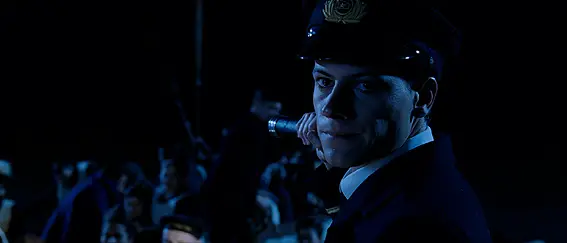
Fifth Officer Lowe (Ioan Gruffudd) thinking about returning to wreck site as portrayed in James Cameron's 1997 film "Titanic". (Click image to enlarge)
An Hour Delay?
Lowe said that he ultimately waited to go back "until the drowning people had thinned out."(US Inquiry, Day 5). In his written, sworn disposition he explained: "The cries of the drowning people had very much subsided, and I thought it safe to venture in amongst them; and to do this I had to transfer all my 58 passengers from my boat into the other 4 boats; and then went away with an empty boat with just a boat's crew and no passengers. I searched the wreck thoroughly and found four persons, three of whom survived, and one died on board my boat." (Harold Lowe's sworn disposition to the British Consulate, 1912, courtesy "On Board RMS Titanic," by George Behe)"
Daisy Minahan did not paint a favorable portrayal of Lowe, alleging that he firstly did not want to return for survivors and that he mistreated her:
Some of the women implored Officer Lowe, of No. 14, to divide his passengers among the three other boats and go back to rescue. His first answer to those requests was, "You ought to be damn glad you are here and have got your own life." After some time he was persuaded to do as he was asked. As I came up to him to be transferred to the other boat he said, "Jump, God damn you, jump." I had showed no hesitancy and was waiting only my turn. He had been so blasphemous during the two hours we were in his boat that the women at my end of the boat all thought he was under the influence of liquor. Then he took all of the men who had rowed No. 14, together with the men from the other boats, and went back to the scene of the wreck. (Senate Inquiry)
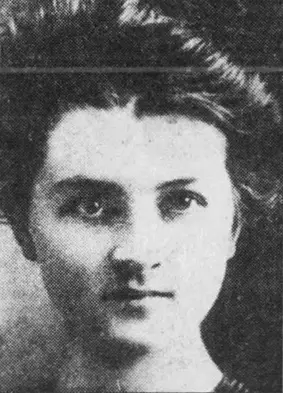
Passenger Daisy Minahan's claimed Lowe was
reluctant to return, but this is not supported by
any other eye-witness.(Encyclopedia Titanica)
However Minahan's portrayal is not supported by any other eyewitness testimony. In fact it seems passengers may have had a say in how soon he went back. Crowe reported: "The officer said we could take 80 people in all, but the ladies seemed to make a protest at his idea of going back again with these people in the boat." (US Inquiry, Day 5)
Crowe's account is supported by Ellen Walcroft, from second class, an occupant of lifeboat 14, who wrote in a letter dated the 23rd of April 1912: "Officer Lowe wanted to go back to the rescue, but the women begged him not to go. He got about four boats together and distributed his passengers amongst them as many as he possibly could and then went back to the rescue." (Maidenhead Advertiser, 29 April 1912, courtesy "On Board RMS Titanic," by George Behe)
First class passenger Sara Compton, also aboard lifeboat 14, said: "Mr. Lowe wished to remain near the ship that he might have a chance to help someone after she sank. Some of the women protested and he replied: 'I don't like to leave her, but if you feel that way about it we will pull away a little distance.'"("The Truth About the Titanic" by Archibald Gracie)
Ultimately Lowe 'lay off', as he described it "until the drowning people had thinned out….I should say an hour and a half; somewhere under two hours." (US Inquiry) AB Scarrott thought it was only "couple of minutes": "When the ship sank, when there was nothing left of her above the water, he waited, I suppose, about a couple of minutes, not more, and ordered all our boats to row where we last saw the ship to see if we could pick up anybody." (British Inquiry)
Conversely AB Frank Evans said "It must have been about an hour and a half, I should think." (US Inquiry)
Senator Smith at the US Inquiry mentioned that Pitman on boat no.5 did not return at all, Lowe then said: "Because he would be hazarding all the rest of their lives. That is the thought that struck me." (US Inquiry, Day 5)
Later Lowe expanded on this:
It would not have been wise or safe for me to have gone there before, because the whole lot of us would have been swamped and then nobody would have been saved... what are you going to do with a boat of 65 where 1,600 people are drowning?...I was just on the margin. If anybody had struggled out of the mass, I was there to pick them up; but it was useless for me to go into the mass….It would have been suicide.(US Inquiry, Day 5)
When Senator Smith suggested he could have saved 15 Lowe replied "You could not do it, sir…made the attempt, sir, as soon as any man could do so, and I am not scared of saying it. I did not hang back or anything else. "(US Inquiry, Day 5)
At the British Inquiry Lowe added it "would have been suicide to go back there until the people had thinned out….it would have been useless to try it, because a drowning man clings at anything…I had to wait until I could be of some use. It was no good going back there to be swamped." (British Inquiry)
Charlottle Collyer confirmed Lowe's fears of returning too early:
Many calls for help came from the floating wreckage, but Fifth Officer Lowe told some women who asked him to go back that it would certainly result in our being swamped. I believe that some of the boats picked up survivors at this time, and I was told afterward by more than one trustworthy person that Captain E.J. Smith was washed against a collapsible boat and held onto it for a few moments. A member of the crew assured me that he tried to pull the captain on board, but that he shook his head, cast himself off and sunk out of sight.
For our part, we went in search of other lifeboats that had escaped. We found four or five, and Mr Lowe took command of the little fleet. He ordered that the boats should be linked together with ropes so as to prevent any one of them from drifting away and losing itself in the darkness. This proved to be a very good plan and made our rescue all the more certain when the Carpathia came.
He then, with great difficulty, distributed most of the women in our boat among the other craft. This took perhaps half-an-hour. It gave him an almost empty boat, and as soon as possible he cut loose and we went in search of survivors. (Washington-Post Semi-Monthly Magazine 26 May 1912, courtesy "On Board RMS Titanic," by George Behe)
Sir Robert Finlay, who headed the White Star Line's representation at the British Inquiry, stated in summary that Lowe was not to be blamed:
"He waited, an operation of the most painful character, requiring great nerve and great coolness, he waited until the sea had done its work with the great majority of people, and then put back and picked up a few of the survivors. But to suggest, as some questions which were put suggested, that there was inhumanity in not pushing into that crowd of drowning people in the hope of saving them, is, I submit, a course based upon ignorance of the fundamental conditions that attend on the endeavour to save people who are struggling in the water when, if you push your boat among them, the only result will be that those in the boat are added to the roll of victims." (British Inquiry)
The Rescue
Lowe recruited possibly up to nine men to return with him to the wreckage to look for survivors. In his sworn disposition he stated that he "went away with an empty boat with just a boat's crew and no passengers." Author George Behe has questioned the accuracy of this as "survivor Charlotte Collyer stated that she was present in Fifth Officer Harold Lowe's lifeboat when Lowe took that boat back to the scene of the sinking to rescue swimmers from the water. (Even though Lowe and other crewmen later claimed that no passengers accompanied them during this rescue attempt, Mrs Collyer's claim is supported by survivor Edith Brown Haisman, who told the present author that she was also present in Lowe's lifeboat during that officer's attempted rescue of swimmers.)" ("On Board RMS Titanic," by George Behe) However, Collyer's account includes references to many events she did not personally witness (such as rumours about the deaths of Captain Smith and First officer Murdoch). Her use of the term "we" can also be interpreted to mean the flotilla - not the returning lifeboat per se. while Haisman was 15-years-old at the time of the disaster and her account varied over the years.
Fireman Threlfall confirmed there were no passengers with Lowe when they returned: "We rowed away from the Titanic some little distance, and Mr. Lowe was able to get several other boats into a bunch. He then transferred all the women and children from one of the boats, and, taking six men, including myself, with him, we rowed towards the Titanic, leaving the women and children in the rest of the boats in the care of two or three men." (Daily Telegraph 29 April 1912, “Titanic – The Homecoming, Tales from the Lapland” by Dr. Paul Lee) Esther Hart also confirmed there were no passengers: "Our officer had collected nearly all the boats together; and he called from one to the other, 'How many in yours - how many in yours?' and then he discovered that there was room in those other boats to put the whole of our 55 in, so we were transferred to them, and the officer now collected a few seamen in his now empty boat and rowed away to see what he could find." (Ilford Graphic 12 May 1912)
It had got a little lighter now, and our officer had collected nearly all the boats together; and he called from one to the other, 'How many in yours - how many in yours?' and then he discovered that there was room in those other boats to put the whole of our 55 in, so we were transferred to them, and the officer now collected a few seamen in his now empty boat and rowed away to see what he could find.An unnamed steward also described the moment of deciding to return and talk of suction. "They rowed away, and Mr. Lowe, who had done more than anyone else, this steward said, to keep people quiet, got the other lifeboats which had preceded his together, and by transferring passengers practically emptied one boat, which was manned by seven men, including the speaker. They proceeded to row towards the wreck with the object of saving as many lives as possible. In this they were successful. … Mr. Lowe said 'Well, boys, I am prepared to row nearer and take my chance. I don't think there's any fear of being sucked down. Are the rest prepared to go?" (Western Daily Mercury 29 April 1912, “Titanic – The Homecoming, Tales from the Lapland” by Dr. Paul Lee)
According to verified occupant AB Frank Evans, from boat no.10, when they went over to the wreckage there were "eight or nine" (US Inquiry). Crowe said that it was "impressed upon us that we must go back to the wreck" and they were volumteers:
Senator BOURNE. Did Officer Lowe call for volunteers to return to the wreck?
Mr. CROWE. No, sir; he impressed upon us that we must go back to the wreck.
Senator BOURNE. Was there any protest?
Mr. CROWE. None whatever, sir. A second-class passenger named Williams, the champion racket player of England, returned with us.
Senator BOURNE. He volunteered his service?
Mr. CROWE. Yes, sir. (US Inquiry)
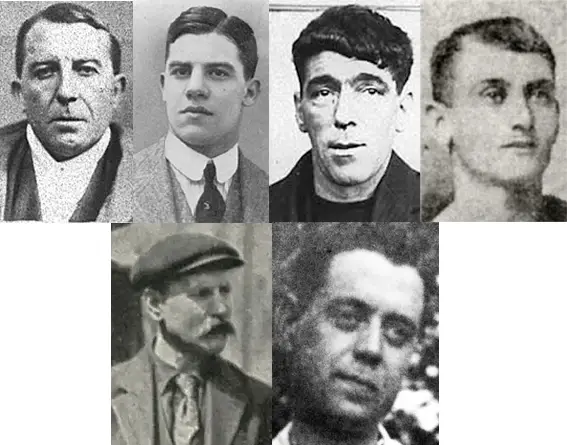
Some of the crew who manned lifeboat 14 that Lowe took back to the wreck site. From top left: AB Joseph Scarrott, Charles Williams, AB Frank Oliver Evans. AB Edward Buly, Lower: Fireman Thomas Threlfall, Saloon Steward George Crowe
Consequently, Lowe was able to organise the following crew to man lifeboat 14:
• AB Joseph Scarrott (from lifeboat 14)
• Saloon steward George Crowe (from lifeboat 14)
• Charles Williams, racket player (from lifeboat 14)
• Thomas Threlfall, leading fireman (from lifeboat 14)
• AB Frank Oliver Evans (from lifeboat 10)
• AB Edward Buly (from lifeboat 10)
Lowe described returning to wreckage as an understandably difficult process, as "it was rather awkward to get in amongst it, because you could not row, because of the bodies. You had to push your way through" (British Inquiry). He explained in detail:
Then I went off and I rowed off to the wreckage and around the wreckage and I picked up four people...Four alive….I do not know who those three live persons were; they never came near me afterwards, either to say this, that, or the other. But one died, and that was a Mr. Hoyt, of New York, and it took all the boat's crew to pull this gentleman into the boat, because he was an enormous man, and I suppose he had been soaked fairly well with water, and when we picked him up he was bleeding from the mouth and from the nose. So we did get him on board and I propped him up at the stern of the boat, and we let go his collar, took his collar off, and loosened his shirt so as to give him every chance to breathe; but, unfortunately, he died. I suppose he was too far gone when we picked him up. But the other three survived. I then left the wreck. I went right around and, strange to say, I did not see a single female body, not one, around the wreckage. "(US Inquiry, Day 5)
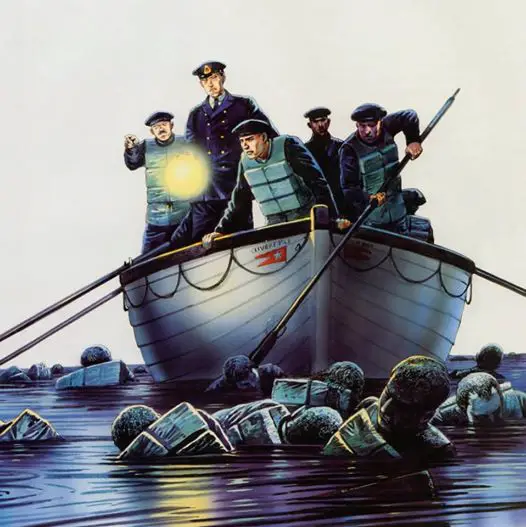
An artist's impression of lifeboat 14 returning for survivors (Titanic - The Disaster That Shocked the World by Mark Dubowski, illustration by Peter Dennis)
AB Scarrott described the grisly task:
During the time that was going on - we intended to make fast ourselves, of course, with the four - we heard cries coming from another direction. Mr. Lowe decided to transfer the passengers that we had, so many in each boat, and then make up the full crew; it did not matter whether it was sailors or anything, and make up the full crew and go in the direction of those cries and see if we could save anybody else. The boats were made fast and the passengers were transferred, and we went away and went among the wreckage. When we got to where the cries were we were amongst hundreds, I should say, of dead bodies floating in lifebelts...
Yes, and the wreckage and bodies seemed to be all hanging in one cluster. When we got up to it we got one man, and we got him in the stern of the boat - a passenger it was, and he died shortly after we got him into the boat. One of the stewards that was in the boat tried means to restore life to the man; he loosed him and worked his limbs about and rubbed him; but it was of no avail at all, because the man never recovered after we got him into the boat. We got two others then as we pushed our way towards the wreckage, and as we got towards the centre we saw one man there. I have since found out he was a storekeeper; he was on top of a staircase; it seemed to be a large piece of wreckage anyhow which had come from some part of the ship. It was wood anyhow. It looked like a staircase. He was kneeling there as if he was praying, and at the same time he was calling for help. When we saw him we were about from here to that wall away from him, and the boats, the wreckage were that thick - and I am sorry to say there were more bodies than there was wreckage - it took us a good half-hour to get that distance to that man to get through the bodies. We could not row the boat; we had to push them out of the way and force our boat up to this man. But we did not get close enough to get him right off - only just within the reach of an oar. We put out an oar on the fore-part of the boat, and he got hold of it, and he managed to hold on, and we got him into the boat. Those three survived. There was one dead in our boat, and that was the passenger, the
first one we picked up. (British Inquiry)
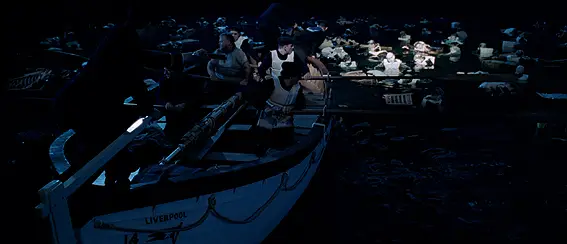
Fifth Officer Lowe (Ioan Gruffudd) and crew rowing through the bodies as portrayed in James Cameron's 1997 film "Titanic". (Click image to enlarge)
Outside of the Inquiry Scarrott gave a more personal account - telling a newspaper that it was so traumatic "we gave way to tears.":
Taking one man from each boat so as to make a crew we rowed away amongst the wreckage as we heard cries for help coming from that direction.
When we got to it the sight we saw was awful. We were amongst hundreds of dead bodies floating in lifebelts. We could only see four alive. The first one we picked up was a male passenger. He died shortly after we got him in the boat.
After a hard struggle we managed to get the other three. One of these we saw kneeling as if in prayer upon what appeared to be part of a staircase. He was only about twenty yards away from us but it took us half-an-hour to push our boat through the wreckage and bodies to get to him; even then we could not get very close so we put out an oar for him to get hold of and so pulled him to the boat.
All the bodies we saw seemed as if they had perished with the cold as their limbs were all cramped up. As we left that awful scene we gave way to tears. It was enough to break the stoutest heart. (The Sphere, 25 May 1912, courtesy "On Board RMS Titanic," by George Behe))
Buly describes turning over the bodies to check if they were alive:
We got away from the ship, and about an hour afterwards Officer Lowe came alongside, and he had his boat filled up, and he distributed them among the other boats, and he said to all the seamen in the boat to jump in his boat until he went back among the wreckage to see if there were any people that had lived…and picked up the remaining live bodies…There were not very many there. We got four of them. All the others were dead…there were a good few dead, sir. Of course you could not discern them exactly on account of the wreckage; but we turned over several of them to see if they were alive. It looked as though none of them were drowned. They looked as though they were frozen. The life belts they had on were that much [indicating] out of the water, and their heads were laid back, with their faces on the water, several of them. Their hands were coming up like that [indicating].(US Inquiry, Day 5)
Crowe mentioned - in contradiction to Lowe's statement of not seeing any female bodies, that they did see the body of a woman:
Returning back to the wreckage, we heard various cries, and endeavored to get among them, and we were successful in doing so and in picking one body up that was floating around in the water; when we got him into the boat - after great difficulty, he being such a heavy man - he expired shortly afterwards. Going farther into the wreckage we came across a steward or one of the crew, and we got him into the boat, and he was very cold and his hands were kind of stiff, but we got him in and he recovered by the time we got back to the Carpathia…also a Japanese or Chinese young fellow that we picked up on top of some of the wreckage - it might have been a sideboard or table - that was floating around. We stopped until daybreak, and we saw in the distance a raft or Berthon boat submerged, in the distance, with a crowd of men on it. We went over to the boat and found probably 20, or there might have been 25, men and 1 woman; also 3 or 4 dead bodies, which we left. Returning again under canvas sail - we stepped our mast at night - we took in tow a collapsible boat containing fully 60 people - women, children, and men. (US Inquiry)
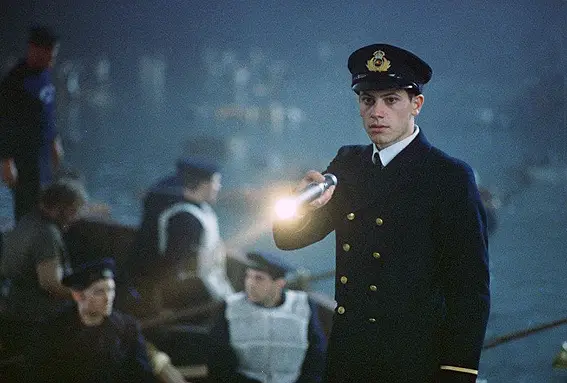
Fifth Officer Lowe (Ioan Gruffudd) and crew rowing through the bodies as portrayed in James Cameron's 1997 film "Titanic". (Click image to enlarge)
AB Frank Evans confirmed the 4 who were rescued with one dying, in addition to the psychological impact of seeing so many dead:
"We picked up four persons alive...One died on the way back, sir. There were plenty of dead bodies about us. You couldn't hardly count them, sir. I was afraid to look over the sides because it might break my nerves down….. I should think between 150 and 200. We had great difficulty in getting through them to get to the wreck." (US Inquiry)
48 year old first class passenger Emily Ryerson, originally in boat no.4, also witnessed the rescue:
"Then we turned to pick up some of those in the water. Some of the women protested, but others persisted, and we dragged in six or seven men; the men we rescued were principally stokers, stewards, sailors, etc., and were so chilled and frozen already they could hardly move. Two of them died in the stern later and many were raving and moaning and delirious most of the time. We had no lights or compass. There were several babies in the boat, but there was no milk or water. (I believe these were all stowed away somewhere, but no one knew where, and as the bottom of the boat was full of water and the boat full of people it was very difficult to find anything.)" (US Inquiry)
Mrs Lily May Futrelle, from first class and likely rescued in lifeboat no.9 had many positive words to say for Lowe who she described as "a leader with a cool head., desperate courage, and a knowledge of the sea" who rescued people with his own hands:
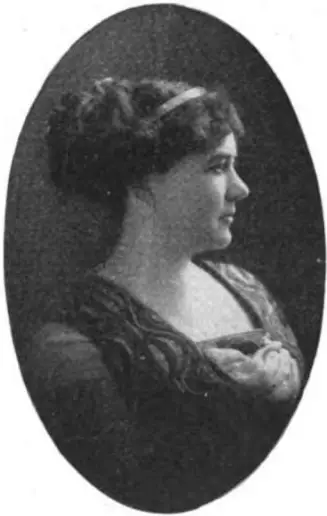
Lily May Futrelle (1876–1967) from The National
Magazine, Volume 36, 1912
It was an emergency which required a leader, and a leader with a cool head., desperate courage, and a knowledge of the sea. The emergency developed the man, It was Fifth Officer Lowe who was in charge of the boats. Without an instant's hesitation he directed the boat in which he was seated to the scene of the upset. An artist's impression of lifeboat 14 discovering a survivor (Titanic - The Disaster That Shocked the World by Mark Dubowski, illustration by Peter Dennis)
He shouted orders to all boats within earshot to move up near the spot where the Titanic sunk and pick up survivors.
He rescued many with his own hands. He seemed to have the power of instilling strength into the horror-stricken limbs of the boat crew and of urging them from struggling survivor to struggling survivor at top speed.
It is hard to conceive the horrible sights that were seen by the survivors in the boats who watched and attempted to assist the men who were struggling for their lives. The iridescence of the water illuminated the faces of the swimmers.
I shall never forget the agony which contorted these faces. The faint light in which we saw them was green and sickly. They begged piteously for help in gasping, strangled voices.
Officer Lowe dragged every person he could reach into our boat. He would lean far over the side, get a hold on the swimmer and pull him straight into the boat. He must have been wonderfully strong. He was as wet as any of the ones he rescued because he pulled them up against his chest and then swung them inward.
The terror which had possessed the men in the lifeboats because of the belief they might be drawn down by the suction following the sinking of the Titanic, was found to be unwarranted.
We were not far from the Titanic when she went down, not so far but what we would have been greatly affected by suction had there been anywhere near as much as there usually is when a vessel sinks.
Within a few minutes Officer Lowe had the situation well in hand. He had picked up those who had tumbled out of the collapsible boat. He had issued orders to the other boats and they were rapidly picking up all the swimmers who had been able to keep their heads above water. When the story of this great maritime disaster has been full told. Fifth Officer Lowe will go down in the annals of the sea as one of the [unreadable] men. (Seattle Daily Times, courtesy "On Board RMS Titanic," by George Behe)
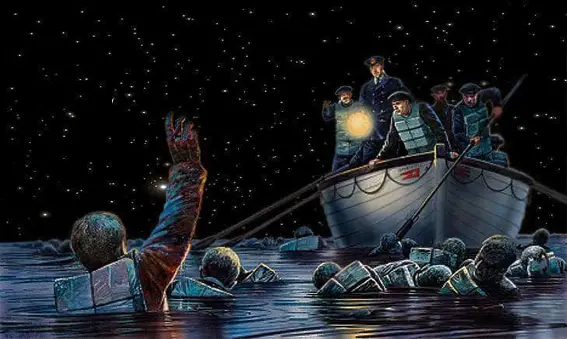
If Lowe's electric torch that he had been given by Dr John Simpson during the loading of lifeboat 14 was still working during the rescue is unconfirmed, although John Poingdestre did testify that "nobody had a light; only Mr. Lowe had a flash electric light belonging to himself, I believe." (British Inquiry) Dr Henry Frauenthal from first class also referenced Lowe's light: "The only light in any of the small boats was a lantern taken off by Fifth Officer Lowe, and his reason for taking it was, as he said, that he had been in two shipwrecks previously and realised its need. It was by the means of this light that the Carpathia was able to sight us, as they saw the light at a distance of ten miles. ("My Experience in the Wreck of the Titanic," American Medicine May 1912, courtesy "On Board RMS Titanic," by George Behe)
The Four Saved
Lowe and his crew were able to save four, one of whom later died. Three of these four individuals have been identified and they are:
1. Mr William Fisher Hoyt - died
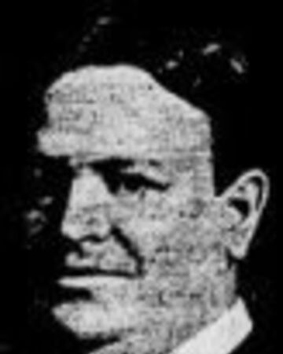
William Fisher Hoyt
Hoyt was a 43 year old American businessman travelling in first class who had joined Titanic in Cherbourg. When Lowe found him in his life jacket. He died shortly after being found. The New York Times of 27 April 1912 stated that Hoyt was the "first victim of the Titanic disaster to be pronounced legally dead.
Harold G. Lowe, fifth officer of the Titanic, told Gordon Hoyt that after the Titanic sank he had heard moaning and had found a large man held up by a life preserver. The man was so heavy that it took all the strength of the lifeboat's crew to get him on board. The man died after being rescued. An affidavit by Lowe was attached to the application for letters of administration. This told how Mr. Hoyt's body had been identified. In his pockets were cards and papers and a watch and chain of peculiar workmanship. The cards included a membership card in the New York Athletic Club and an identification card issued by the Fidelity and Casualty Company of New York. Mr. Hoyt was buried at sea from the Carpathia on April 16, Lowe stated." (The New York Times,27 April 1912)
2. Steward Harold Phillimore - survived
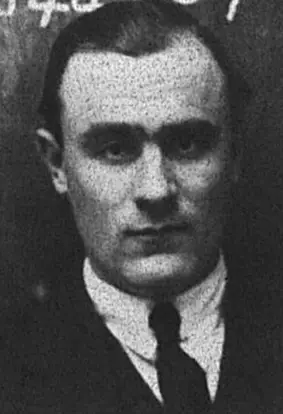
Steward Harold Phillimore (Encyclopedia Titanica)
Phillimore was a 23 year old British saloon steward in second class. According to Encyclopedia Titanica "Harold remained on the Titanic during her final throes and managed to climb aboard some floating wreckage where he spent time with another man who later died of exposure. He was one of only a very few men rescued from the water by lifeboat 14 … Phillimore spied the boat approaching and called out, with Lowe and his crew responding by travelling towards him and extending out an oar for him to grasp. Such was his frozen condition though that he was unable to grasp it but he was eventually hauled into boat 14." (Encyclopedia Titanica)
Phillimore must be the "storekeeper" that Scarrot referenced, as there is also mention of using an oar to rescue him: "a storekeeper; he was on top of a staircase; it seemed to be a large piece of wreckage anyhow which had come from some part of the ship. It was wood anyhow. It looked like a staircase. He was kneeling there as if he was praying, and at the same time he was calling for help… it took us a good half-hour to get that distance to that man to get through the bodies. We could not row the boat; we had to push them out of the way and force our boat up to this man. But we did not get close enough to get him right off - only just within the reach of an oar. We put out an oar on the fore-part of the boat, and he got hold of it, and he managed to hold on, and we got him into the boat. Those three survived. There was one dead in our boat, and that was the passenger, the first one we picked up."(British Inquiry)
3. Fang Lang - Chinese sailor - survived
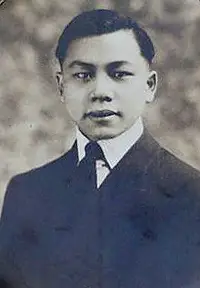
Chinese sailor Fang Lang
(GazetteXtra)
Variously identified as a passenger, sailor and "small Japanese" the actual identity of the individual saved by Lowe has for some time been mostly uncertain. According to a dramatic retelling by second class passenger Charlotte Collyer, most likely an occupant of lifeboat 14, the saving of this sailor caused an interesting change in Lowe's appraisal of the man:
A little further on, we saw a floating door that must have been torn loose when the ship went down. Lying upon it, face downward, was a small Japanese. He had lashed himself with a rope to his frail raft, using the broken hinges to make the knots secure. As far as we could see, he was dead. The sea washed over him every time the door bobbed up and down, and he was frozen stiff. He did not answer when he was hailed, and the officer hesitated about trying to save him.
"What's the use?" said Mr Lowe. He's dead, likely, and if he isn't there's others better worth saving than a j--!"
He had actually turned our boat around; but he changed his mind and went back. The Japanese was hauled on board, and one of the women rubbed his chest, while others chafed his hands and feet. In less time than it takes to tell, he opened his eyes. He spoke to us in his own tongue; then, seeing that we did not understand, he struggled to his feet, stretched his arms above his head, stamped his feet, and in five minutes or so had almost recovered his strength. One of the sailors near to him was so tired that he could hardly pull his oar. The Japanese bustled over, pushed him from his seat, took the oar and worked like a hero until we were finally picked up. I saw Mr Lowe watching him in open-mouthed surprise.
"By Jove!" muttered the officer. "I'm ashamed of what I said about the little blighter. I'd save the likes o' him six times over, if I got the chance." (The Semi-Monthly Magazine, May 1912, How I was Saved from the Titanic)
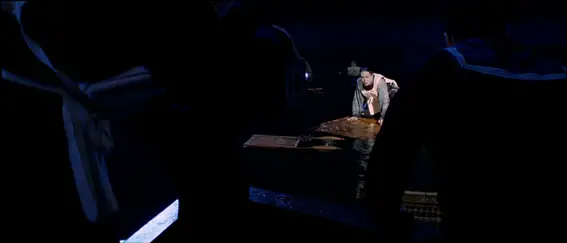
Fifth Officer Lowe (Ioan Gruffudd) and crew discover a Chinese man as portrayed in a deleted scene from James Cameron's 1997 film "Titanic". (Click image to enlarge)
This Chinese sailor was one of eight sailors from Hong Kong who boarded Titanic at Southampton as paying third class passengers, travelling together on the same ticket. Of the eight, two died:
Lee Ling - died
Len Lam - died
Leaving us with six names, one of whom Lowe rescued:
Lee Bing - survived
Chang Chip -survived
Choong Foo -survived
Ling Hee --survived
Ali Lam --survived
Fang Lang - rescued
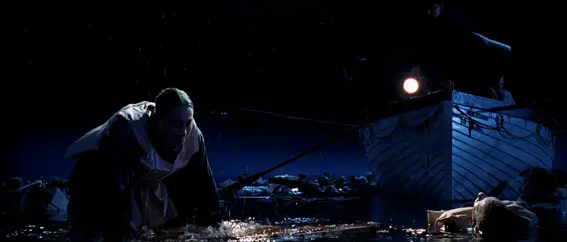
Fifth Officer Lowe (Ioan Gruffudd) and crew rescue a Chinese man as portrayed in a deleted scene from James Cameron's 1997 film "Titanic". (Click image to enlarge)
According to a new documentary entitled "The Six" by Arthur Jones and Steven Schwankert (with executive producer James Cameron) about the surviving Chinese sailors, the identity of the sailor that Lowe saved has been confirmed as Fang Lang:
Fang’s story is particularly harrowing: He was found floating on a door to which he had tied himself. After he was pulled — freezing — from the wreckage, he tirelessly rowed the lifeboat to safety and was praised for his efforts, according to accounts that Jones and his team collected. The 1997 film recreated Fang’s rescue, but the scene was not included in the final cut. He never said a word to his son, Tom Fong — who appears in “The Six.”
(Sixth Tone, Link: http://www.sixthtone.com/news/1000733/titanics-chinese-survivors-resurface-from-depths-of-history)If accurate, Fang Lang was aged 26, unmarried and was travelling to New York with his eight colleagues from the Donald Line's Anetta, as a fireman.
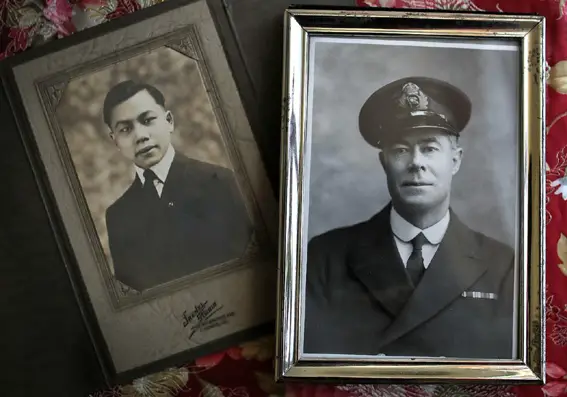
Portraits of Fang Lang (real name Wing Sun Fong) Harold Lowe. (Credit: https://www.gazettextra.com/)
(Click image to enlarge)
According to a 22 September 2019 edition of the GazetteXtra, his real name was Wing Sun Fong and he was 17 years old. "Tom Fong, Wing Sun’s son, is a Janesville resident… said his father never shared with him... Fong said throughout his childhood and as a young adult his relatives had hinted that his father had survived a shipwreck, but Fong said his father never spoke about the accident to him or his mother."

Fang Lang's grandson Tom Fong
(Credit: https://www.gazettextra.com/)
Tom Fong at the time of the article being written was 59 years old - his father 65 years old when was born. "Wing Sun spoke little English and died almost 40 years ago." However a cousin had casually mentioned in 2003 "You know, the Titanic: That was the shipwreck your dad survived.” During the research for the documentary it was established that "Fong said researchers now know Wing Sun wrote to relatives on Xiachuan about his survival...one person on the island has poetry Fong wrote to them detailing his struggle to stay afloat in the frigid ocean as others in the frigid water cried for help from the darkness surrounding him.""
The Unknown survivor - Robert Daniel or Emilio Portaluppi?
The fourth is presently unknown. There does not seem to be any description by Lowe or the rescue crew to help with identifying this man. One possibility, raised by Vitaly Savinkin of the Russian Titanic Society, is that it was Robert Daniel, a 27-year-old first class passenger. A contemporary newspaper report stated:
“I had not taken time to dress and wore only a bathrobe. Under this I had slipped a life preserver. It didn't seem to me that we were sinking, but the waters seemed rising up over us. Finally, I jumped in and I was struggling about among the ice cakes, fighting for my life, when I was rescued…. There were several shots fired, however. I saw one man discharge a revolver several times to frighten others away from a lifeboat and then got into it himself. In fact, I saw him afterwards in the very lifeboat that picked me up." (April, 20, 1912, The New York Times)
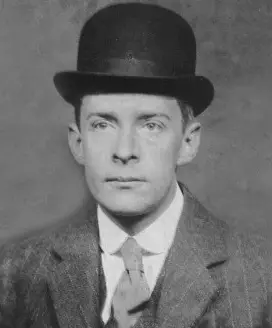
Robert Williams Daniel, 1915, courtesy
the National Archives and Records
Administration/Mike Poirier.
The officer who fired a revolver several times in lifeboat 14 that also rescued people is of course, Fifth Officer Lowe. So it is interesting that Daniel then adds "I saw him afterwards in the very lifeboat that picked me up."
On another occasion he reported he was "far up on one of the top decks when I jumped. About me were many others in the water. My bathrobe floated away, and it was icily cold. I struck out at once." (Titanic –Tibballs, p.89). However it looks like we can rule out Daniel as a possibility after the release of a thoroughly researched article on Encyclopedia Titanica entitled A Titanic Mystery: Exploring the Escape of Robert W. Daniel by Randy Bryan Bigham, Richard Edwards and Brandon Whited, which concluded that he was most likely rescued from the water by lifeboat 4 - the occupants of which were later redistributed in Lowe's flotilla of lifeboats 4, 10 12 and collapsible D.
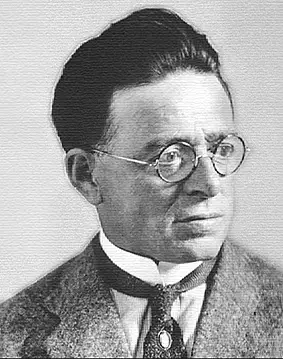
Emilio Ilario Giuseppe Portaluppi, 1930s
(Encyclopedia Titanica)
Another possible candidate is Emilio Ilario Giuseppe Portaluppi, a 30-year-old Italian-American Second class passenger. The Times newspaper reported:
Emilio Portaluppi, a second cabin passenger, shows that he was first awakened by the explosion of one of the ship's boilers. He hurried up to deck one and strapped on a lifebelt. Following the example of others, he then leapt into the sea, and held on to an icefloe, with the help of which he managed to keep afloat until he was seen by those in the lifeboats and rescued. (The Times, April 20, 1912)
Worcester Telegram
New York, April 19.- A huge cake of ice was the means of aiding Emilo Portaluppi of Aricgabo, Italy, in escaping death when the Titanic went down. Portaluppi, a second class passenger, was awakened by the explosion of one of the boilers of the ship. He hurried to the deck, strapped a life preserver around him and following the example of others, leaped into the sea. With the aid of the preserver and by holding on to a cake of ice he managed to keep afloat. He was seen by one of the lifeboats and picked up. There were 35 other people in the boat when he was hauled aboard.
The Milford Cabinet:
No women were about on the deck where he stood, and he attempted to get into the lifeboat. Luck was against him, or seemed to be, for he lost his footing and fell into the ocean … When he hit the water Mr Portalupi found that he was not alone. and many others were swimming or floating in the icy, numbing water. At once he struck out and had succeeded in putting four or five hundred yards between himself and the ship before she took the final plunge... As time went on and the first streaks of dawn made it possible to distinguish objects the half-frozen man in the Water saw near him a woman, supported by a life preserver, and also a child which had succumbed to the cold and died. One of the lifeboats, passing near, came within ear shot, and the crew rescued the man and woman, pulling both into the boat. Here also the cold was almost intolerable. and of the men and women in the frail craft, three died front the exposure before the Carpathia reached them. Their bodies were taken aboard and buried at sea.
But in another newspaper report, Portaluppi described the lifeboat he was rescued in having "room for at least 10 more people. Three men died in the boat from expsoure before they were rescued" which does not tally with being rescued from the water by Lowe. (Barre Daily Times 4/22/12,, courtesy of Mike Poirier)
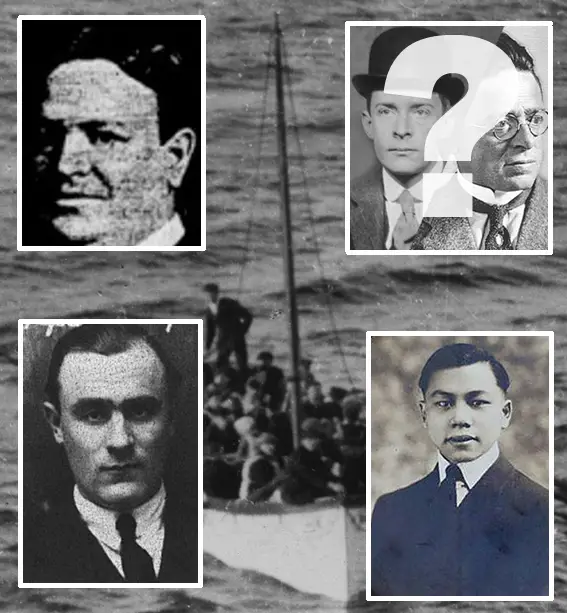
The four people rescued from the water by Fifth Officer Lowe, clockwise from top left: William Hoyt (died); Robert Daniel or Emilio Portaluppi; Fang Lang; Harold Phillimore
See also...
Next... Collapsibles & Carpathia